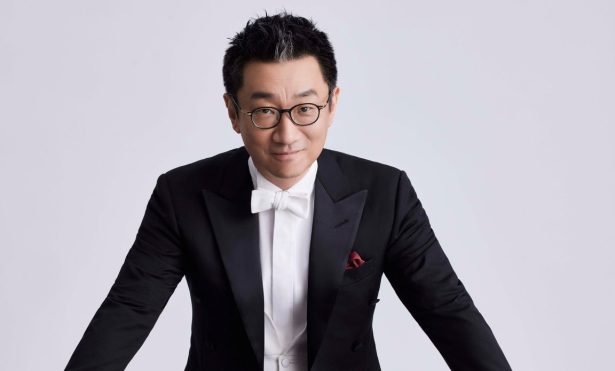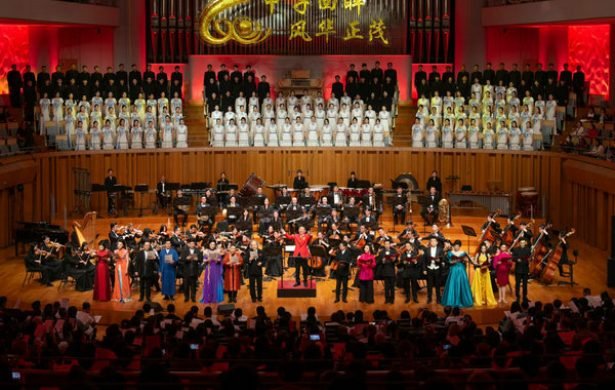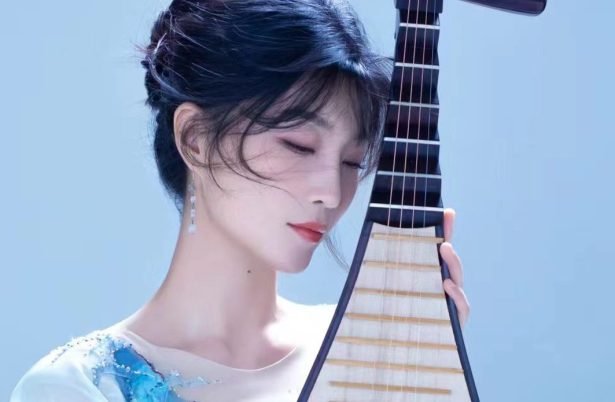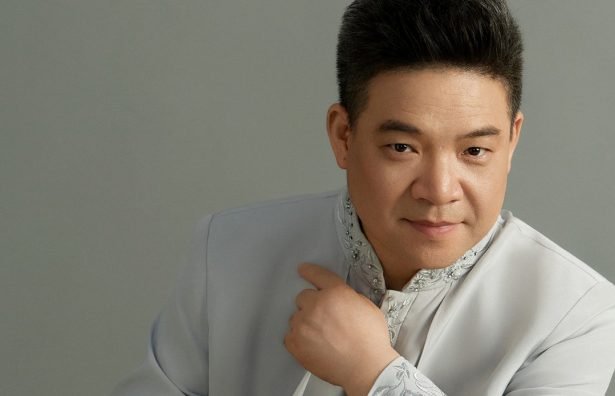It Was Chinese to Me
“Hmmm that’s different…” I murmur to myself. The opening bars of the The Festival Overture, by Shi Wanchun sets the scene for unusual tonalities for the rest of the evening. The jampacked Henry Le Boeuf Hall, in the Bozar – The Centre for Fine Arts, in Brussels, suggests that this is exactly what the audience wants. The magnificent auditorium, designed by Victor Horta, is electric with anticipation of this Chinese New Year celebration, with the China Conservatory of Traditional Music Orchestra.
The bell rings. We fall silent. A disembodied announcer informs us that there is a change to the published program. The modifications mean nothing to me because I probably know more about the secret life of flies on the slopes of the Himalayas than I do about Chinese traditional music. I am here to learn and to enjoy.
The house erupts as the orchestra enters from both stage right and stage left. The musicians are about 50 in number. The ladies make an enchanting entrance. The space between each artist is exactly equidistant. Their robes are a stunning shade of scarlet with gold embellishments. The bodice section of their gowns are figure hugging. From the waist down, it then swish-swishes to the floor in silky crimson waterfalls of grace and elegance.

Conductor Li Xincao © Li Xincao

The China Conservatory of Traditional Music European Tour © chinadaily.com
The gentlemen sport less flamboyant attire. They take position on stage, with the same, near military precision, as did the ladies. Their black suits and shirts are a stark backdrop to the feminine effervescence. Their only flash of colour is their Trump-like red ties.
To a man, we raucously rise to welcome Li Xincao. Audience and orchestra unite to acknowledge the President of the China Conservatory of Traditional Music and Artistic Director of the China Conservatory of Traditional Music Orchestra – our conductor tonight.
There is a reason why the tonality of the overture sounds deliciously unfamiliar. I have grown up with a Western tonal system that is now hard-wired into my DNA. This Western tuning absolute divides an octave into 12 equal steps. Since the 18th century this has been known as 12 equal temperaments. They define the tones and semi-tones that we know and love.
In juxtaposition, most Chinese music uses a pentatonic scale, with the intervals almost the same as those of the major pentatonic scale – a five-note scale. Rhythm is a vital characteristic of Chinese music. The rhythm is often based on a 4/4-time signature. However, some traditional Chinese music may feature a 6/8-time signature, which is prevalent in Northern Chinese music.
Overture over, the conductor leaves the podium, only to return, a few moments later, to the rapturous applause of the orchestra. It rises to its feet with respect. This, not only for him, but also for Ma Ke, a virtuoso on the Erhu. She is a celebrated artist in her own right. Ma Ke is a respected teacher in the China Conservatory of Traditional Music. She holds the coveted position of first-chair Erhu performer in the China Conservatory of Traditional Music Orchestra. After being mentored by the renowned Erhu soloist Song Fei, Ma Ke has gone on to win an impressive catalogue of awards.
The erhu is a Chinese two-stringed, bowed, musical instrument. It is used as a solo instrument, both in small ensembles and as well as in large orchestras. The erhu can be traced back to proto-Mongolic instruments which first appeared in China during the Tang dynasty.
Ma Ke’s gown is the colour of freshly churned butter, with gold thread in filigree. One would be forgiven for thinking that she was to be a star attraction at the Paris Fashion Week – but took a wrong turn and ended up, centre stage, in Brussels. There is palpable delight in the house because she has chosen to play the fourth movement of the Nostalgic Dreams of Beijing concerto. It is aptly named “New Year’s Eve”. She bows in the afterglow of her rendition. Rock star level adulation rains down on her.
She shakes the hand of the First Violin. She acknowledges the conductor. Then she bows with deep, deep, humility to acknowledge an audience on the cusp of explosive ecstasy.
Ma Ke playing the Erhu

Yang Tingting with a pipa © Yang Tingting
The conductor leaves the podium, once again. This time he returns with another escapee from the Paris Fashion Week, in the shape of Yang Tingting – an internationally venerated maestro on the Pipa. The pipa, sometimes called the Chinese lute, has a pear-shaped wooden body with a varying number of frets ranging from 12 to 31. When the hero worshipping finally dies down, she takes position. She takes a deep breath and then she launches into The Clouds and Flowers Fantasy, a Pipa concerto, by Wang Danhong. Her dazzling, full-length silk gown is the colour of freshly harvested olives with splashes of lime. The limoncello coloured gilded embroidery seems to give the garment a life of its own. She sways into the melody energetically. Her long sleeves are flying flags of grace. The par terre and the three galleries are spellbound.
The Chinese New Year heralds the start of Spring. It evokes the awakening of nature after snowy slumber. The natural environment, the clouds, the wind, the euphony of birdsong, the gurgling of a brook channelling melting mountain snow all form the creative pantry for the arts. How appropriate that this veneration of mother nature should be expressed in an auditorium built by Victore Horta – the grandfather of Art Nouveau. This stylistic movement, that swept across Europe, was also inspired by form and function in nature. Horta captured the nation and indeed the continent, with his subtle flamboyance so completely, that to this day, the signature whiplash motif is still the symbol of Brussels.
The now familiar, impromptu, fashion parade continues. This time the conductor returns, escorting Zhang Qianyuan to the dais. Each step she takes is an affirmation of sophisticated charm, sheathed in a frock of ivory and oyster hues. The erstwhile, ubiquitous gold embellishments now give way to trove of diamond-bright silver medallions that twinkle and wink as she moves. Gently, she draws us into the southing “Hundreds of Birds Worshiping the Phoenix – a concerto for suona, a traditional Shandong melody, arranged by Ren Tongxiang.
The suona is a traditional, double-reeded, Chinese musical instrument that originated in Iran. It appeared in China around the 3rd century. It gained popularity in parts of northern and southern China, including Shandong. Usually, this instrument has a distinctively loud and high-pitched sound. However, Zhang Qianyuan is an Associate Professor in the suona department at the China Conservatory of Traditional Music. She brought all the “Hundreds of worshipping birds” into Bozar. There was the deep sound of heavy jungle birds, with long beaks and multicoloured plumage. But most impressively, she brought to life the hummingbird lightness of families of the house finch, the humble sparrow and the robin. Each delicate note floated down in slow motion only to land with weightless precision on a drop of morning due.
Zhang Qianyuan, suona solo: Birds Saluting Phoenix

Wang Zhongshan – guzheng virtuoso © Elbphilharmonie
After well-deserved adoration, she made a Bidenesque exit, stage right. She quickly realized her faux pas. She spins round on her heel and heads in the right direction. On her corrected trajectory, she stops centre stage and honours the house with the most theatrical of bows, then smiles, then waved, then was gone. Anyone who didn’t love her before certainly loved her then.
The celebration of 3000 years of traditional Chinese music comes to an end all too soon. Our final soloist is Wang Zhongshan. His pedigree is no less illustrious than that of the three ladies who preceded him. Wang is Director of the Department of Traditional Chinese Music at the China Conservatory of Traditional Music. He pulls his scarlet and gold Noel Coward like smoking jacket close. Quietly he focuses on his guzheng. The applause wanes. He plucks at the 21 strings of the zither like instrument. Rhythmically we are drawn into Man Jiang Hong, a guzheng concerto composed by He Zhanhao.
Reluctantly, we realise “That’s All Folks”. So enthralled were we with, not only, the sounds and the magical presence of each soloist, but also with the majesty of the orchestra, that we forgot that we were plunged into new culture and a new tonality, a mere two hours ago. Music has that wonderful power for diverse peoples and cultures to forget our differences. It reminds us that we can live together in harmony.

